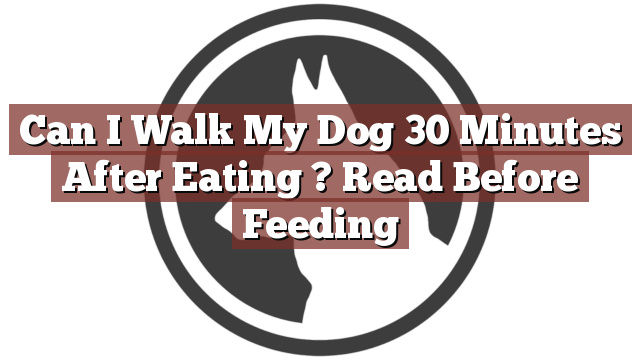Understanding Your Dog’s Dietary Needs
Understanding your dog’s dietary needs is crucial for their overall health and well-being. As a responsible dog owner, it is essential to be aware of what and when to feed your furry friend. Dogs, just like humans, require proper nutrition to sustain their energy levels and maintain a healthy weight. A balanced diet consisting of high-quality dog food is essential for their growth, development, and overall health.
Can I Walk My Dog 30 Minutes After Eating? Read Before Feeding
Can dogs eat right before going for a walk? This is a common question that arises among dog owners. The short answer is no. It is generally not recommended to walk your dog immediately after they have finished eating. Giving your dog some time to digest their meal is important to prevent discomfort and potential health issues.
It is advisable to wait at least 30 minutes to an hour after your dog has eaten before taking them for a walk. This allows for proper digestion and reduces the risk of bloating or gastric torsion, which can be life-threatening conditions for dogs. Walking too soon after a meal can cause the food to move around more rapidly in their stomach, potentially leading to digestive problems.
Pros and Cons of Feeding Your Dog Before a Walk
Feeding your dog before a walk has both pros and cons that should be taken into consideration. One advantage of feeding your dog before a walk is that it can provide them with the necessary fuel for physical activity. Dogs require energy to be active, and having a meal before a walk can help provide that energy boost.
On the other hand, there are potential downsides to feeding your dog right before a walk. Some dogs may experience discomfort or even vomiting if they engage in strenuous exercise immediately after eating. Additionally, certain dog breeds, such as those prone to bloating, are more susceptible to gastric issues when exercised on a full stomach. It is important to consult with your veterinarian to understand your dog’s specific needs and any breed-related concerns.
Conclusion: Considerations for Walking Your Dog After Eating
In conclusion, it is generally best to wait at least 30 minutes to an hour after your dog has eaten before taking them for a walk. This allows for proper digestion and reduces the risk of potential health issues. Although dogs require energy to be active, feeding them right before a walk may lead to discomfort or digestive problems, especially for certain breeds.
Remember to consider your dog’s individual needs, such as their breed and any pre-existing health conditions, before deciding when to feed them before a walk. Consulting with your veterinarian is always recommended to ensure you are providing the best care for your furry companion. By understanding your dog’s dietary needs and making informed decisions, you can help ensure their overall well-being and enjoyment during walks.
Thank you for taking the time to read through our exploration of [page_title]. As every dog lover knows, our furry friends have unique dietary needs and responses, often varying from one canine to another. This is why it's paramount to approach any changes in their diet with caution and knowledge.
Before introducing any new treats or making alterations to your dog's diet based on our insights, it's crucial to consult with a veterinarian about [page_title]. Their expertise ensures that the choices you make are well-suited to your particular pet's health and well-being.
Even seemingly harmless foods can sometimes lead to allergic reactions or digestive issues, which is why monitoring your dog after introducing any new food item is essential.
The content provided here on [page_title] is crafted with care, thorough research, and a genuine love for dogs. Nevertheless, it serves as a general guideline and should not be considered a substitute for professional veterinary advice.
Always prioritize the expert insights of your veterinarian, and remember that the health and happiness of your furry companion come first.
May your journey with your pet continue to be filled with joy, love, and safe culinary adventures. Happy reading, and even happier snacking for your canine friend!

